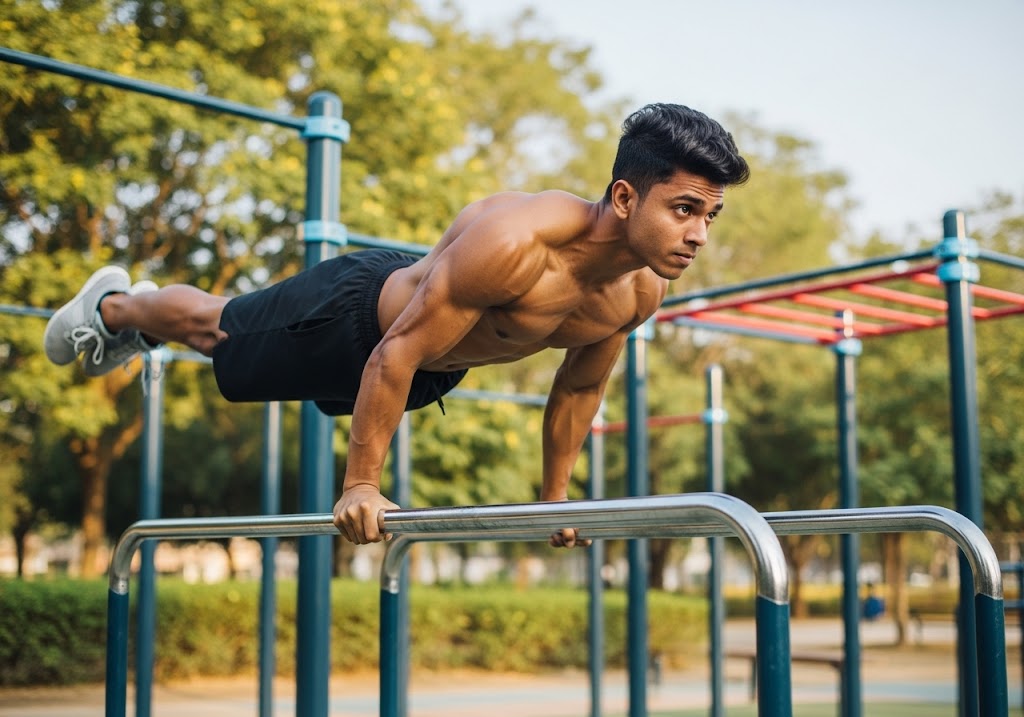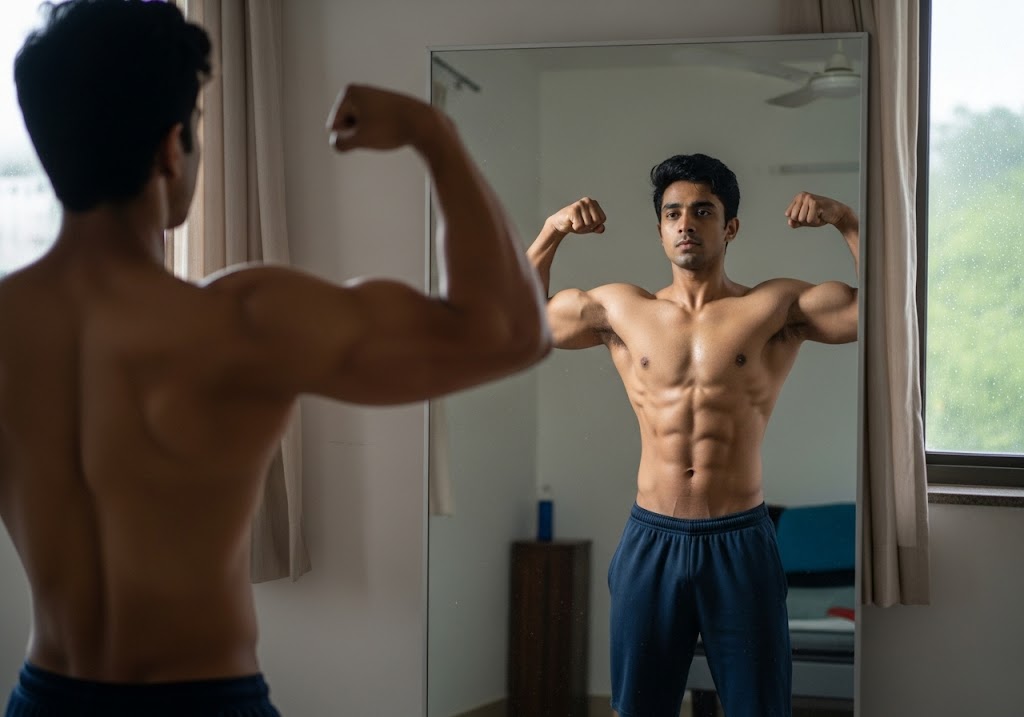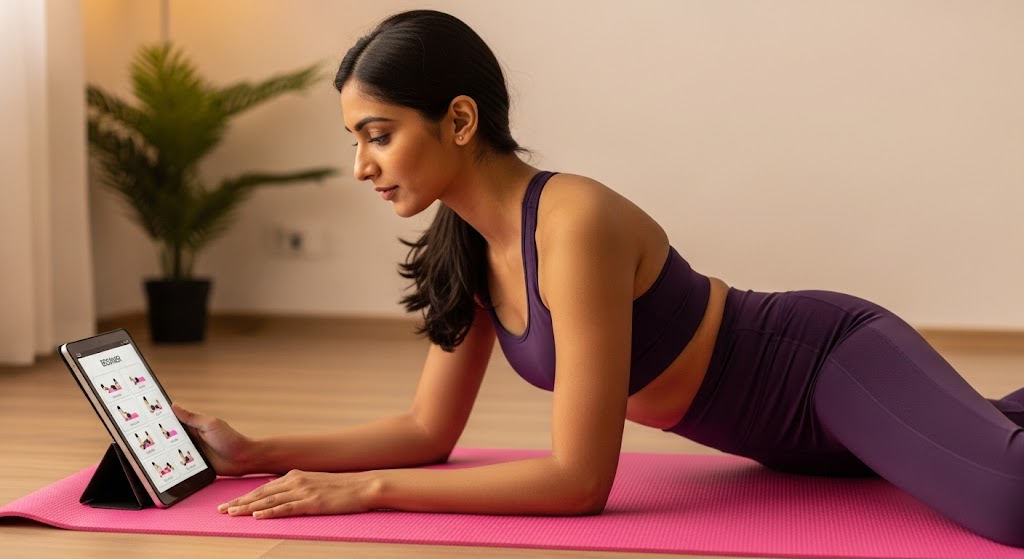20 Calisthenics at Home No Equipment Exercises: Push-ups for chest strength, Squats for leg power, Planks for core stability, Lunges for balance, Mountain Climbers for cardio, Burpees for endurance, Pike Push-ups for shoulders, Jump Squats for explosive legs, Glute Bridges for hamstrings, Wall Sits for leg endurance, High Knees for cardio, Jumping Jacks for full-body warm-up, Tricep Dips for arm tone, Single-Leg Glute Bridges for stability, Bear Crawls for coordination, Crab Walks for posterior chain, Superman for lower back, Side Planks for obliques, Russian Twists for core rotation, Inchworms for flexibility.
Staying fit has never been easier with calisthenics at home no equipment required. This amazing training method lets you build strength, muscle, and endurance using only your body weight. Whether you’re stuck at home, traveling, or simply prefer privacy, calisthenics at home no equipment offers the perfect solution for your fitness needs. The beauty of this approach is that you can start immediately, regardless of your fitness level or budget. With calisthenics at home no equipment, you have complete control over your workout schedule and environment, making it easier to maintain consistency and achieve your fitness goals.
Table of Contents
20 Calisthenics at Home No Equipment Exercises
These essential exercises form the foundation of effective home-based calisthenics training without requiring any equipment or gym membership. Each movement targets multiple muscle groups while requiring minimal space, making them perfect for busy schedules and small living areas. Master these bodyweight exercises to build strength, endurance, and coordination from the comfort of your home.
Exercise Overview Table
| Sr.No. | Exercise | Target Muscles | Difficulty | Space Needed |
|---|---|---|---|---|
| 1 | Push-ups | Chest, shoulders, triceps | Beginner | 6×3 feet |
| 2 | Squats | Legs, glutes, core | Beginner | 3×3 feet |
| 3 | Planks | Core, shoulders, back | Beginner | 6×3 feet |
| 4 | Lunges | Legs, glutes, balance | Beginner | 4×3 feet |
| 5 | Mountain Climbers | Full body, cardio | Intermediate | 6×3 feet |
| 6 | Burpees | Full body, cardio | Intermediate | 6×3 feet |
| 7 | Pike Push-ups | Shoulders, upper chest | Intermediate | 6×3 feet |
| 8 | Jump Squats | Legs, power, cardio | Intermediate | 4×4 feet |
| 9 | Glute Bridges | Glutes, hamstrings | Beginner | 6×3 feet |
| 10 | Wall Sits | Legs, endurance | Beginner | Wall space |
| 11 | High Knees | Cardio, hip flexors | Beginner | 3×3 feet |
| 12 | Jumping Jacks | Full body, cardio | Beginner | 4×4 feet |
| 13 | Tricep Dips | Triceps, shoulders | Intermediate | Chair/edge |
| 14 | Single-Leg Glute Bridges | Glutes, stability | Intermediate | 6×3 feet |
| 15 | Bear Crawls | Full body, coordination | Intermediate | 8×4 feet |
| 16 | Crab Walks | Posterior chain | Intermediate | 8×4 feet |
| 17 | Superman | Lower back, glutes | Beginner | 6×3 feet |
| 18 | Side Planks | Obliques, lateral core | Intermediate | 6×3 feet |
| 19 | Russian Twists | Core, obliques | Beginner | 4×3 feet |
| 20 | Inchworms | Full body, flexibility | Intermediate | 8×3 feet |
Wondering if bodyweight routines can really pack on muscle? does calisthenics build muscle
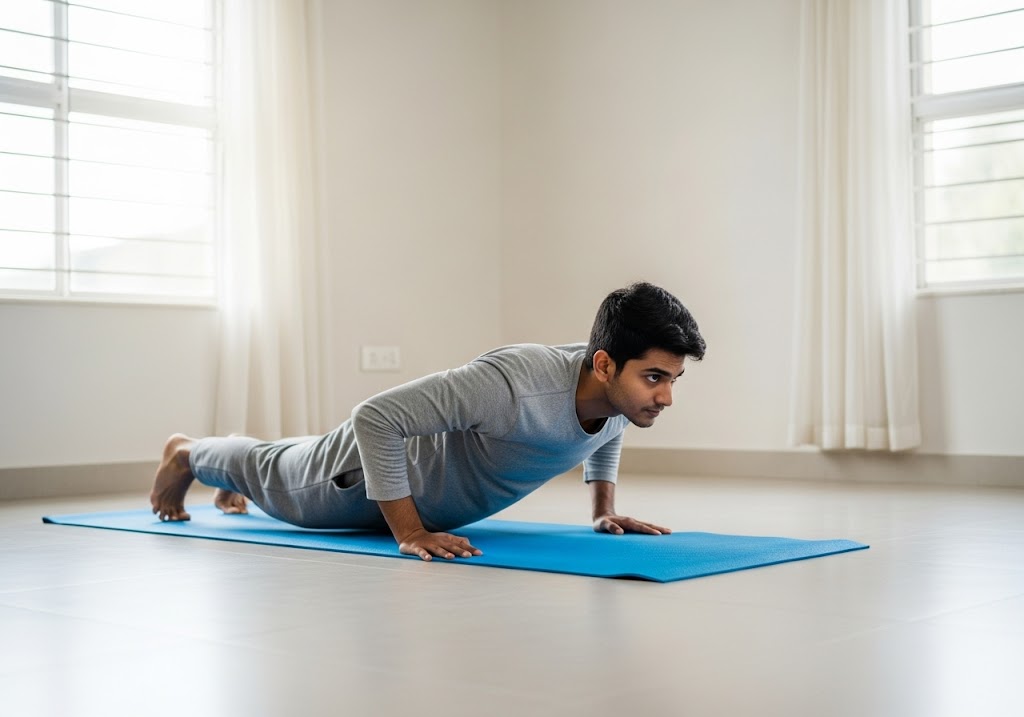
Detailed Exercise Instructions
1. Push-ups
Push-ups serve as the cornerstone of home calisthenics training, building chest, shoulder, and tricep strength while engaging core muscles for stability. This foundational exercise can be modified for any fitness level, from wall push-ups for beginners to one-arm variations for advanced practitioners. Proper form involves maintaining a straight line from head to heels throughout the movement, ensuring maximum effectiveness and safety for long-term strength development.
How to Do Push-ups?
- Start in plank position with hands slightly wider than shoulders, lower chest toward ground by bending elbows
- Keep body straight from head to heels, avoiding sagging hips or piking up
- Push back to starting position with control, focusing on chest and tricep engagement
2. Squats
Squats form the foundation of functional lower body strength, targeting quadriceps, hamstrings, and glutes while improving hip mobility and balance. This essential movement pattern mimics daily activities like sitting and standing, making it crucial for maintaining independence and mobility throughout life. Proper squat technique involves sitting back into the movement while keeping the chest up and knees tracking over the toes for optimal muscle activation and joint safety.
How to Do Squats?
- Stand with feet shoulder-width apart, lower by pushing hips back and bending knees until thighs parallel to ground
- Keep chest up and weight on heels, ensuring knees track over toes throughout movement
- Drive through heels to return to standing position, squeezing glutes at the top
3. Planks
Planks represent the ultimate core exercise for building deep abdominal strength and shoulder stability without any equipment requirements. This isometric hold improves posture, prevents back pain, and creates a strong foundation for all other exercises and daily activities. Starting with shorter holds and gradually increasing duration allows proper strength development while maintaining perfect form, which is more important than impressive hold times with compromised positioning.
How to Do Planks?
- Start in forearm plank with elbows under shoulders, maintain straight line from head to heels
- Engage core by gently drawing belly button toward spine while breathing normally
- Hold for 15-60 seconds depending on fitness level, focusing on perfect alignment over duration
4. Lunges
Lunges provide excellent unilateral leg training that improves balance while strengthening legs and glutes through functional movement patterns. This exercise helps correct muscle imbalances between legs while building strength that translates directly to walking, climbing stairs, and other daily activities. The single-leg nature challenges balance and coordination while developing the stability necessary for athletic performance and injury prevention throughout the lower body.
How to Do Lunges?
- Step forward into lunge position, keeping front knee over ankle and back knee hovering above ground
- Lower straight down rather than forward, maintaining upright torso throughout movement
- Push through front heel to return to starting position, alternating legs or completing one side first
5. Mountain Climbers
Mountain climbers combine cardiovascular training with core strengthening through rapid alternating leg movements that elevate heart rate significantly. This dynamic exercise improves coordination while building endurance in the core, shoulders, and legs simultaneously. The plank position challenges upper body stability while the leg movement provides cardiovascular conditioning, making mountain climbers excellent for time-efficient workouts that address multiple fitness components in one exercise.
How to Do Mountain Climbers?
- Start in high plank position, alternate driving knees toward chest while maintaining stable upper body
- Keep core engaged and avoid bouncing hips, focusing on controlled explosive movement
- Continue rapid alternating pattern for 30-60 seconds, maintaining plank alignment throughout
Find out are burpees good for belly fat.
6. Burpees
Burpees represent the ultimate full-body challenge, combining squat, plank, push-up, and jump movements into one comprehensive exercise. This demanding movement builds explosive power, cardiovascular endurance, and mental toughness while working every major muscle group. Though challenging, burpees provide exceptional fitness benefits and can be modified for different fitness levels, making them valuable additions to any home workout routine for serious fitness development.
How to Do Burpees?
- Start standing, drop to squat position and place hands on ground, jump feet back to plank
- Perform push-up, jump feet back to squat, then explosively jump up with arms overhead
- Land softly and immediately begin next repetition, maintaining rapid but controlled pace
7. Pike Push-ups
Pike push-ups specifically target shoulder development while building strength for advanced movements like handstand push-ups. This exercise creates a strong foundation for vertical pressing movements while requiring no equipment beyond floor space. The inverted position challenges shoulder stability and strength through a different angle than regular push-ups, making pike push-ups essential for comprehensive upper body development and preparation for advanced calisthenic skills.
How to Do Pike Push-ups?
- Start in downward dog position with hands shoulder-width apart, walk feet closer to hands
- Lower head toward hands by bending elbows while keeping hips elevated
- Press back to starting position, maintaining pike angle throughout the movement
8. Jump Squats
Jump squats add explosive power development to traditional squats, building leg strength and improving athletic performance through plyometric training. This exercise enhances muscle power, bone density, and cardiovascular fitness while requiring minimal space for execution. The explosive upward movement followed by soft landing teaches proper landing mechanics while building the fast-twitch muscle fibers essential for athletic performance and functional movement in daily activities.
How to Do Jump Squats?
- Perform regular squat, then explode upward into jump while extending arms overhead
- Land softly back into squat position with bent knees to absorb impact
- Immediately descend into next squat, maintaining continuous movement for desired repetitions
9. Glute Bridges
Glute bridges specifically target the posterior chain, strengthening glutes and hamstrings while improving hip mobility and counteracting prolonged sitting effects. This exercise helps correct common postural problems while building strength in often-weak posterior muscles essential for lower back health. The lying position makes glute bridges accessible to all fitness levels while providing excellent muscle activation for building strong, functional glutes that support proper movement patterns.
How to Do Glute Bridges?
- Lie on back with knees bent and feet flat on floor, lift hips up by squeezing glutes
- Create straight line from knees to shoulders at top position, avoiding overarching back
- Lower hips with control back to starting position, focusing on glute activation throughout
10. Wall Sits
Wall sits build leg endurance and mental toughness through isometric training that requires no equipment beyond wall space. This exercise develops muscular endurance while teaching proper squat positioning with the support of a wall for reference. Wall sits can be performed anywhere and provide excellent strength building benefits while being low-impact and accessible to most fitness levels, making them perfect for building leg strength foundation.
How to Do Wall Sits?
- Lean against wall with back flat, slide down until thighs are parallel to ground
- Keep knees at 90-degree angles and weight evenly distributed across both feet
- Hold position for 15-60 seconds while breathing normally, maintaining proper alignment
Learn how many calories do you burn doing 100 sit ups and the breakdown of how many calories are burned in sit ups.
11. High Knees
High knees provide excellent cardiovascular training while strengthening hip flexors and improving running mechanics through rapid leg cycling movements. This exercise elevates heart rate quickly while building leg strength and coordination, making it perfect for warm-ups or cardio intervals. The standing position makes high knees accessible while the rapid movement provides intense conditioning benefits that improve athletic performance and overall cardiovascular health in minimal time.
How to Do High Knees?
- Stand tall and rapidly drive knees up toward chest while pumping arms in running motion
- Aim to bring knees to hip level or higher, landing on balls of feet between drives
- Continue rapid alternating motion for 30-60 seconds, maintaining upright posture throughout
12. Jumping Jacks
Jumping jacks offer full-body cardiovascular training through coordinated arm and leg movements that improve agility and conditioning. This classic exercise engages multiple muscle groups while providing excellent warm-up benefits and cardiovascular challenge. The simple movement pattern makes jumping jacks accessible to most fitness levels while the continuous motion provides sustained heart rate elevation for effective cardiovascular training and calorie burning.
How to Do Jumping Jacks?
- Start with feet together and arms at sides, jump feet apart while raising arms overhead
- Jump feet back together while lowering arms to sides in coordinated movement
- Maintain steady rhythm and land softly on balls of feet throughout continuous jumping pattern
13. Tricep Dips
Tricep dips specifically target the back arm muscles while building functional pushing strength using minimal equipment like a chair or step. This exercise complements push-ups by working the triceps through a different angle while requiring only a stable edge for support. Proper progression from assisted to full dips allows gradual strength building while the exercise effectively targets often-neglected tricep muscles essential for complete upper body development.
How to Do Tricep Dips?
- Sit on chair edge with hands beside hips, walk feet forward and support weight on hands
- Lower body by bending elbows straight back, keeping shoulders over wrists
- Push through palms to return to starting position, focusing on tricep engagement throughout movement
14. Single-Leg Glute Bridges
Single-leg glute bridges advance basic glute bridges by adding unilateral training that challenges balance while building stronger glutes and addressing muscle imbalances. This progression requires greater stability and strength from the working leg while improving hip stability essential for walking, running, and athletic performance. The single-leg nature makes this exercise more challenging while providing excellent functional strength benefits that translate to improved movement quality.
How to Do Single-Leg Glute Bridges?
- Lie on back with one knee bent and other leg extended, lift hips using single leg
- Keep extended leg straight and avoid rotating hips, focusing on working glute
- Hold briefly at top position before lowering with control, completing all reps before switching
15. Bear Crawls
Bear crawls provide comprehensive full-body training that builds coordination, strength, and endurance through primal movement patterns. This exercise challenges core stability while building shoulder strength and improving coordination between upper and lower body movements. Bear crawls engage multiple muscle groups simultaneously while teaching proper movement mechanics that translate to improved athletic performance and functional movement capabilities in daily activities.
How to Do Bear Crawls?
- Start on hands and knees, lift knees 2-3 inches off ground while maintaining flat back
- Move forward by advancing opposite hand and foot simultaneously in controlled steps
- Keep hips low and core engaged, taking small steps while maintaining stable position
Learn techniques on how to lift heavier weights safely.
16. Crab Walks
Crab walks target the posterior chain through unique positioning that challenges often-neglected back muscles while improving shoulder stability. This exercise builds strength in the glutes, hamstrings, and upper back while teaching coordination in an inverted position. The reverse movement pattern helps counteract forward-focused daily activities while building functional strength that supports posture and reduces risk of back problems through comprehensive posterior muscle development.
How to Do Crab Walks?
- Sit with hands behind body and feet in front, lift hips into reverse bridge position
- Walk backward or forward by moving opposite hand and foot while maintaining elevated hips
- Keep chest open and hips high throughout movement, focusing on posterior muscle engagement
17. Superman
Superman exercises specifically target the lower back muscles and glutes while improving spinal strength and posture. This exercise helps counteract the effects of prolonged sitting while building strength in often-weak back muscles essential for spinal health. The prone position makes superman exercises accessible while providing targeted strengthening for the erector spinae and glutes, making it excellent for building back strength and reducing lower back pain risk.
How to Do Superman?
- Lie face down with arms extended overhead, simultaneously lift chest, arms, and legs off ground
- Keep neck neutral and avoid excessive arching, focusing on back muscle engagement
- Hold for 2-5 seconds at top position before lowering with control to starting position
18. Side Planks
Side planks target oblique muscles and lateral core stability through frontal plane training that complements traditional forward-facing exercises. This unilateral exercise builds strength in often-neglected lateral core muscles while challenging balance and coordination. Side planks help create balanced core development while addressing asymmetries that can lead to injury, making them essential for comprehensive core training and improved athletic performance.
How to Do Side Planks?
- Lie on side with forearm on ground, elbow under shoulder, lift hips creating straight line
- Keep body in single plane without rotating forward or backward, engaging lateral core
- Hold for 15-45 seconds per side, maintaining proper alignment throughout hold
19. Russian Twists
Russian twists target the core muscles and obliques through rotational movement patterns that improve spinal mobility and strength. This exercise challenges the core through rotation while building endurance in the midsection muscles. The seated position makes Russian twists accessible while the twisting motion provides benefits for sports and daily activities that require rotational strength and core stability for optimal performance and injury prevention.
How to Do Russian Twists?
- Sit with knees bent and lean back slightly, lifting feet off ground if possible
- Rotate torso side to side while keeping chest up and core engaged throughout
- Move with control rather than momentum, focusing on oblique muscle activation during rotation
20. Inchworms
Inchworms combine full-body strength training with flexibility improvement through dynamic movement that challenges coordination and mobility. This exercise works the entire body while improving hamstring flexibility and shoulder stability through the walking motion. Inchworms provide excellent warm-up benefits while building functional strength through movement patterns that translate to improved flexibility and strength for daily activities and athletic performance.
How to Do Inchworms?
- Return to standing position and repeat, focusing on controlled movement and flexibility
- Start standing, bend forward placing hands on ground, walk hands out to plank position
- Hold plank briefly, then walk hands back toward feet while keeping legs straight
Just getting started? Here’s how to begin: how to start calisthenics
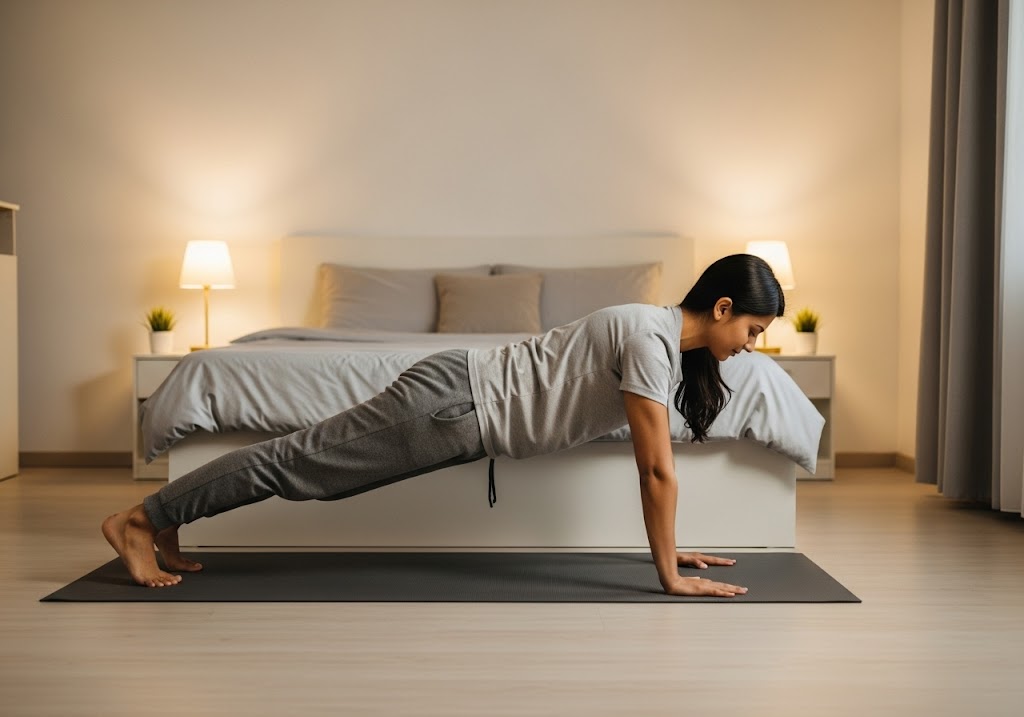
What is Calisthenics at Home No Equipment?
Calisthenics at home no equipment is a training method that uses your body weight as resistance to build strength, flexibility, and endurance. This approach eliminates the need for expensive gym equipment, memberships, or dedicated workout spaces, making fitness accessible to everyone regardless of budget or location.
The practice focuses on natural movement patterns that work multiple muscle groups simultaneously, creating functional strength that translates directly to daily activities. With calisthenics at home no equipment, your body becomes your gym, and your home becomes your personal training space, offering complete control over your fitness journey.
Which builds upper-body strength better: push ups or the bench press? push ups vs bench press
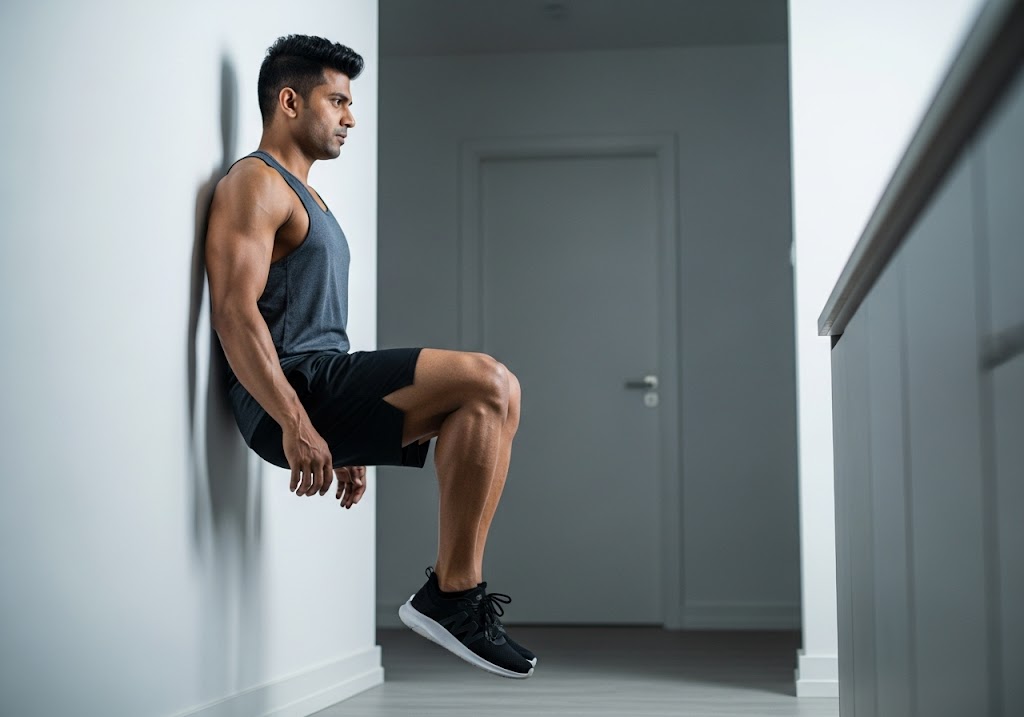
Do You Need Any Equipment?
The beauty of calisthenics at home no equipment lies in its name – you truly need nothing but your body and determination. This training method was designed to be completely equipment-free, allowing you to work out anywhere, anytime. Your body weight provides all the resistance needed for effective strength training and muscle development.
While basic calisthenics at home no equipment requires nothing, some optional accessories can enhance comfort and variety. A yoga mat provides cushioning for floor exercises, while a timer helps track workout intervals. However, these items are conveniences, not necessities – you can achieve excellent results with absolutely no equipment at all.
Learn proper form and technique for chest gains: how to do dumbbell bench press
Calisthenics at home with no equipment – Upper, Lower, Core & Full-body
Transform your body using nothing but your own bodyweight with this complete calisthenics routine. Perfect for beginners and advanced practitioners alike, these exercises build strength, endurance, and flexibility without requiring any gym equipment or special space.
Upper body (pushing) calisthenics with no equipment
Pushing exercises form the foundation of upper body strength, targeting your chest, shoulders, and triceps. These movements build pressing power essential for daily activities and athletic performance. Progress from basic push-ups to advanced variations, focusing on controlled movements and full range of motion for maximum muscle development.
| Exercise | Sets | Reps/Duration | Target Muscles | Notes |
| Push-ups | 3 | 8-15 | Chest, shoulders, triceps | Modify on knees if needed |
| Pike Push-ups | 3 | 5-10 | Shoulders, upper chest | Hands wider than shoulders |
| Tricep Dips | 3 | 8-12 | Triceps, chest | Use chair or floor |
| Diamond Push-ups | 3 | 5-10 | Triceps, inner chest | Form diamond with hands |
| Wall Handstand Push-ups | 2 | 3-8 | Shoulders, triceps | Advanced – use wall for support |
Upper body (pulling) calisthenics with no equipment
Pulling exercises are challenging without equipment but crucial for balanced development. These movements target your back, rear delts, and biceps, counteracting forward posture from daily activities. Creative alternatives using household items or bodyweight positions help develop pulling strength and improve posture effectively.
| Exercise | Sets | Reps/Duration | Target Muscles | Notes |
| Superman | 3 | 10-15 | Lower back, glutes | Hold for 2-3 seconds |
| Reverse Angels | 3 | 10-15 | Rear delts, upper back | Lying face down |
| Prone Y-T-W | 3 | 8 each position | Upper back, shoulders | Form Y, T, W with arms |
| Inverted Rows | 3 | 5-12 | Lats, rhomboids, biceps | Use table or sturdy surface |
| Door Frame Rows | 3 | 8-12 | Upper back, biceps | Use towel around door frame |
Lower body calisthenics with no equipment
Lower body strength is fundamental for everyday movement, athletic performance, and injury prevention. These exercises target your glutes, quadriceps, hamstrings, and calves while improving balance and coordination. Bodyweight movements provide excellent functional strength that translates directly to real-world activities and sports performance.
| Exercise | Sets | Reps/Duration | Target Muscles | Notes |
| Bodyweight Squats | 3 | 12-20 | Quads, glutes, calves | Focus on form |
| Lunges | 3 | 10 each leg | Quads, glutes, hamstrings | Alternate or static |
| Single-leg Glute Bridges | 3 | 8-12 each leg | Glutes, hamstrings | Squeeze at top |
| Calf Raises | 3 | 15-20 | Calves | Pause at top |
| Jump Squats | 3 | 8-12 | Explosive power, legs | Land softly |
| Single-leg Calf Raises | 3 | 10-15 each leg | Calves | Use wall for balance |
Core calisthenics with no equipment
Your core is the powerhouse connecting upper and lower body movements. These exercises strengthen deep stabilizing muscles, improve posture, and enhance performance in all other activities. Focus on controlled movements and proper breathing to build functional core strength that protects your spine and improves overall movement quality.
| Exercise | Sets | Reps/Duration | Target Muscles | Notes |
| Plank | 3 | 30-60 seconds | Core, shoulders | Keep body straight |
| Mountain Climbers | 3 | 20 total | Core, cardio | Keep hips level |
| Bicycle Crunches | 3 | 20 total | Abs, obliques | Control the movement |
| Dead Bug | 3 | 8 each side | Deep core | Opposite arm/leg |
| Russian Twists | 3 | 20 total | Obliques, core | Lean back slightly |
| Hollow Body Hold | 3 | 20-45 seconds | Deep core | Press lower back down |
Full-body workout calisthenics with no equipment
Combine all movement patterns for maximum efficiency and time-saving workouts. Full-body routines improve coordination, burn more calories, and provide balanced muscle development. These structured approaches help you progress systematically while maintaining variety and preventing workout plateaus through strategic exercise selection and scheduling.
3-Day Split Schedule
| Day | Focus | Exercises | Sets | Reps/Duration | Rest Between Sets |
| Day 1 | Upper (Pushing) + Core | Push-ups | 3 | 8-15 | 60-90 sec |
| Pike Push-ups | 3 | 5-10 | 60-90 sec | ||
| Tricep Dips | 3 | 8-12 | 60-90 sec | ||
| Plank | 3 | 30-60 sec | 60-90 sec | ||
| Dead Bug | 3 | 8 each side | 60-90 sec | ||
| Day 2 | Lower + Upper (Pulling) | Bodyweight Squats | 3 | 12-20 | 60-90 sec |
| Lunges | 3 | 10 each leg | 60-90 sec | ||
| Single-leg Glute Bridges | 3 | 8-12 each leg | 60-90 sec | ||
| Superman | 3 | 10-15 | 60-90 sec | ||
| Reverse Angels | 3 | 10-15 | 60-90 sec | ||
| Day 3 | Full-Body Circuit | Circuit A or B (see below) | 3 rounds | As specified | 2-3 min between rounds |
Benefits of Calisthenics at Home No Equipment
Training with calisthenics at home no equipment offers numerous advantages over traditional gym workouts. This method builds functional strength while improving flexibility, balance, and coordination. The convenience and cost-effectiveness make it sustainable for long-term fitness success without financial burden.
- Cost-Effective: No gym fees, equipment costs, or transportation expenses required
- Convenience: Train anytime, anywhere without depending on facility hours
- Functional Strength: Builds real-world applicable strength and movement patterns
- Scalability: Exercises modify easily for all fitness levels and abilities
- Time Efficient: No travel time or equipment setup needed
- Privacy: Train comfortably without gym intimidation or social pressure
Curious about fat burn in leg training: calories burned in lunges
Calisthenics at Home – No Equipment Sample Workout
Transform your body using nothing but your own bodyweight with this complete calisthenics routine. Perfect for beginners and advanced practitioners alike, these exercises build strength, endurance, and flexibility without requiring any gym equipment or special space.
Sample Workout Routine
| Exercise | Sets | Reps/Duration | Target Muscles | Notes |
| Warm-up | ||||
| Jumping Jacks | 1 | 30 seconds | Full body | Light cardio warm-up |
| Arm Circles | 1 | 10 forward, 10 backward | Shoulders | Prepare joints for movement |
| Bodyweight Squats | 1 | 10 | Legs, glutes | Activation movement |
| Upper Body | ||||
| Push-ups | 3 | 8-15 | Chest, shoulders, triceps | Modify on knees if needed |
| Pike Push-ups | 3 | 5-10 | Shoulders, upper chest | Hands wider than shoulders |
| Tricep Dips | 3 | 8-12 | Triceps, chest | Use chair or floor |
| Plank | 3 | 30-60 seconds | Core, shoulders | Keep body straight |
| Lower Body | ||||
| Bodyweight Squats | 3 | 12-20 | Quads, glutes, calves | Focus on form |
| Lunges | 3 | 10 each leg | Quads, glutes, hamstrings | Alternate or static |
| Single-leg Glute Bridges | 3 | 8-12 each leg | Glutes, hamstrings | Squeeze at top |
| Calf Raises | 3 | 15-20 | Calves | Pause at top |
| Core & Conditioning | ||||
| Mountain Climbers | 3 | 20 total | Core, cardio | Keep hips level |
| Bicycle Crunches | 3 | 20 total | Abs, obliques | Control the movement |
| Dead Bug | 3 | 8 each side | Deep core | Opposite arm/leg |
| Burpees | 2 | 5-10 | Full body | High intensity finisher |
| Cool Down | ||||
| Standing Forward Fold | 1 | 30 seconds | Hamstrings, back | Gentle stretch |
| Child’s Pose | 1 | 30 seconds | Back, shoulders | Relaxation position |
| Seated Spinal Twist | 1 | 15 seconds each side | Spine, obliques | Gentle rotation |
Tips for Success
- Rest: 30-60 seconds between sets, 1-2 minutes between exercises
- Frequency: 3-4 times per week with rest days
- Progression: Increase reps or add extra sets as you get stronger
- Form: Quality over quantity – maintain proper form throughout
Listen to your body: Stop if you feel pain (different from muscle fatigue)
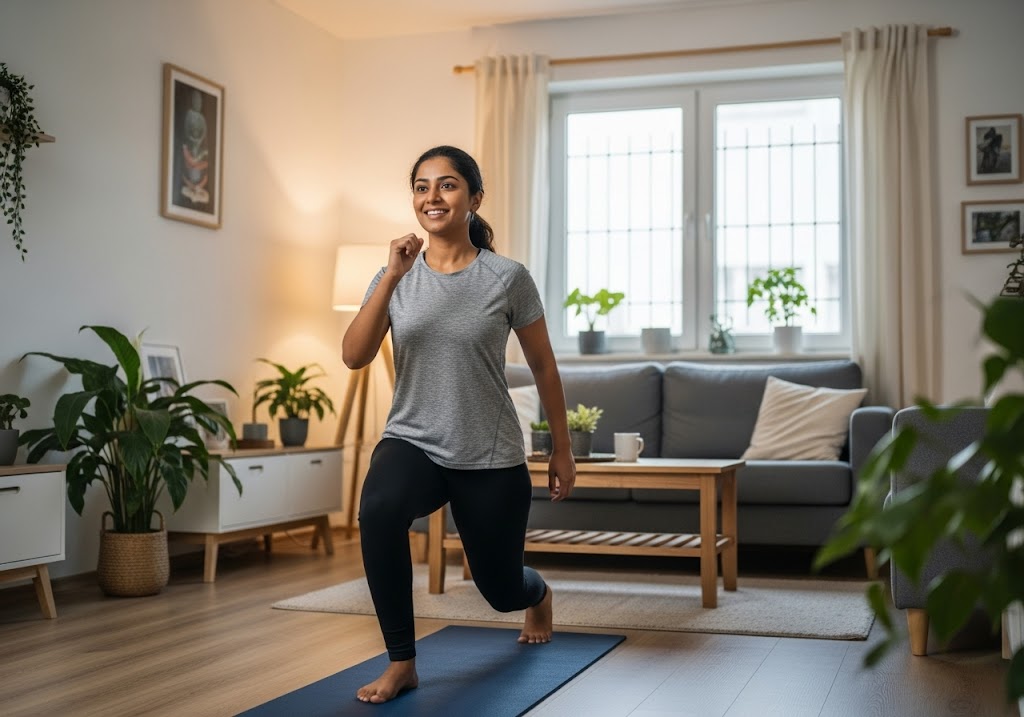
Common Mistakes in Home Calisthenics
The most frequent error in calisthenics at home no equipment is prioritizing quantity over quality. Many people rush through exercises without proper form, reducing effectiveness and increasing injury risk. Focus on perfect form during every repetition of your routine for optimal results.
- Poor Form: Rushing through exercises without maintaining proper technique
- Skipping Warm-up: Starting intense training without adequate preparation
- Inconsistent Training: Sporadic workouts instead of regular, sustainable practice
- Progressing Too Fast: Attempting advanced moves before mastering basics
- Neglecting Recovery: Not allowing adequate rest between training sessions
Want bigger arms with zero weights: how to make biceps at home without dumbbells
How to Stick to Your Workout Plan?
Consistency is the key to success with calisthenics at home no equipment training. Create a realistic schedule that fits your lifestyle and commitments. Start with shorter, more frequent sessions rather than long, infrequent workouts. This approach builds sustainable habits that become automatic over time.
Track your progress to maintain motivation and see tangible improvements. Set specific, measurable goals like “hold a plank for 60 seconds” rather than vague objectives. Celebrate small victories and use setbacks as learning opportunities. Remember that building strength with calisthenics exercises takes time and patience, but the results are worth the effort.
Find out the calorie burn behind those core moves: how many calories do Russian twists burn
Calisthenics for Beginners – No Equipment Exercises
Calisthenics for beginners requires zero equipment while building functional strength through natural bodyweight movements. These exercises develop coordination, balance, and muscle strength using only your body as resistance. Perfect for home workouts, travel fitness, or those starting their fitness journey without gym access or expensive equipment investments.
Beginner Calisthenics Exercise Program
| Exercise | Sets | Reps/Duration | Rest | Primary Target | Difficulty | Space Needed |
|---|---|---|---|---|---|---|
| Wall Push-ups | 2-3 | 8-15 reps | 30-45 sec | Chest, Arms | Beginner | 3×3 feet |
| Bodyweight Squats | 2-3 | 10-15 reps | 45-60 sec | Legs, Glutes | Beginner | 3×3 feet |
| Modified Plank | 2-3 | 15-30 seconds | 30-45 sec | Core | Beginner | 6×3 feet |
| Standing Marching | 2-3 | 10-15 per leg | 20-30 sec | Core, Balance | Beginner | 2×2 feet |
| Glute Bridges | 2-3 | 10-15 reps | 30-45 sec | Glutes, Hamstrings | Beginner | 6×3 feet |
| Arm Circles | 2-3 | 30 seconds each direction | 20-30 sec | Shoulders | Beginner | Arm span |
| Calf Raises | 2-3 | 15-20 reps | 20-30 sec | Calves | Beginner | 2×2 feet |
| Stationary Lunges | 2-3 | 6-10 per leg | 30-45 sec | Legs, Balance | Beginner | 4×3 feet |
| Knee Push-ups | 2-3 | 5-12 reps | 45-60 sec | Chest, Arms | Beginner | 6×3 feet |
| Wall Sits | 2-3 | 15-30 seconds | 45-60 sec | Legs, Endurance | Beginner | Wall space |
| Side Steps | 2-3 | 8-12 per side | 30-45 sec | Hips, Legs | Beginner | 6×3 feet |
| Standing Side Bends | 2-3 | 8-12 per side | 20-30 sec | Core, Obliques | Beginner | 3×3 feet |
| Heel-to-Toe Walk | 2-3 | 10-20 steps | 30-45 sec | Balance | Beginner | 10 feet line |
| Single-Leg Balance | 2-3 | 15-30 sec per leg | 30-45 sec | Balance, Stability | Beginner | 2×2 feet |
| Mountain Climbers | 2-3 | 10-20 reps | 45-60 sec | Core, Cardio | Beginner+ | 6×3 feet |
The No-Gym Full-Body Calisthenics Circuit Training for Beginners
This beginner-friendly circuit combines essential movements for comprehensive calisthenics at home no equipment training. Perform each exercise for the specified duration, rest briefly between exercises, and complete 2-3 rounds. This circuit targets all major muscle groups while building cardiovascular endurance.
| Exercise | Duration | Rest | Rounds |
| Wall Push-ups | 30 seconds | 15 seconds | 2-3 |
| Bodyweight Squats | 30 seconds | 15 seconds | 2-3 |
| Plank Hold | 20 seconds | 15 seconds | 2-3 |
| Marching in Place | 30 seconds | 15 seconds | 2-3 |
| Glute Bridges | 30 seconds | 15 seconds | 2-3 |
| Arm Circles | 20 seconds | 15 seconds | 2-3 |
Learn about how to do a one arm push up for advanced bodyweight challenges.
Weekly Plan for Calisthenics at Home – No Equipment
A structured weekly plan ensures balanced training and adequate recovery for calisthenics at home no equipment practice. This schedule provides optimal frequency while allowing muscle recovery. Adjust intensity based on your fitness level and recovery needs for sustainable progress.
| Day | Workout Type | Duration | Focus |
| Monday | Full Body Circuit | 20-30 minutes | Strength & Cardio |
| Tuesday | Calisthenics Ab Workout | 15-20 minutes | Core Focus |
| Wednesday | Rest or Light Stretching | 10-15 minutes | Recovery |
| Thursday | Calisthenics Chest Exercises | 20-25 minutes | Upper Body |
| Friday | Calisthenics Leg Exercises | 20-25 minutes | Lower Body |
| Saturday | Full Body Circuit | 25-35 minutes | Complete Training |
| Sunday | Rest or Active Recovery | 15-20 minutes | Recovery |
Learn about how many planks should I do a day for core exercise frequency planning.
Staying Motivated for Home Training
Maintaining motivation for calisthenics at home no equipment requires setting clear, achievable goals and tracking progress consistently. Create a dedicated workout space and establish a routine that becomes automatic. Find ways to make training enjoyable through music, variety, and personal challenges.
- Set Specific Goals: Target measurable achievements like “20 push-ups” or “60-second plank”
- Track Progress: Keep a workout log to see improvements over time
- Create Routine: Train at the same time daily to build automatic habits
- Find Accountability: Share goals with friends or join online communities
- Reward Progress: Celebrate milestones with non-food rewards
- Stay Flexible: Adjust plans when life interferes rather than giving up completely
Check out unilateral vs bilateral training to understand different training approaches.
Creating Your Home Workout Space
Effective calisthenics at home no equipment requires minimal space but benefits from thoughtful setup. You need enough room to perform exercises safely without hitting furniture or walls. A space roughly 6 feet by 6 feet provides adequate room for most routines and movements. Clear your workout area of obstacles and ensure adequate ceiling height for jumping movements. Good lighting helps you maintain proper form and prevents accidents during your sessions. Proper ventilation keeps you comfortable and helps regulate body temperature during intense workouts.
- Floor surface: Use a non-slip mat or carpet for stability and joint protection
- Wall space: Helpful for wall push-ups, handstand practice, and stretching
- Ceiling height: Ensure adequate clearance for jumping and overhead movements
Consider the noise factor when choosing your workout location, especially if you live in an apartment. Jumping exercises can be loud, so you might need to modify movements or choose appropriate workout times for your calisthenics at home no equipment practice.
Explore bodybuilding exercises at home for complete strength training routines.
Conclusion
Calisthenics at home no equipment offers an accessible, effective, and sustainable approach to fitness that can transform your body and health. By mastering fundamental movements and progressing systematically, you can build impressive strength, endurance, and body control using only your body weight. The convenience and cost-effectiveness of this training method make it an ideal choice for busy lifestyles and tight budgets. Remember that consistency beats intensity, and proper form trumps high repetitions. Start your calisthenics at home no equipment journey today with realistic expectations and unwavering commitment. Whether you’re focusing on calisthenics biceps exercises or full-body routines, your body is the only equipment you need to achieve remarkable fitness results. With dedication to calisthenics at home no equipment, you’ll discover that the most effective gym is the one you carry with you everywhere.
Want to master the calisthenics handstand and take your skills to the next level? Whether you’re a beginner or pushing advanced skills, ISC – Indian School of Calisthenics offers expert guidance to help you master bodyweight training. Visit us at SRPF Ground, NH8, Goregaon (E), Mumbai – 400065. For class schedules, personalized coaching, or more details, call +91 77159 53218. Train smart, move better, and unlock your back strength with ISC.
Calisthenics at Home No Equipment – FAQs
Can I build muscle with calisthenics at home no equipment?
Yes, calisthenics at home no equipment effectively builds muscle through progressive overload. Focus on increasing reps, sets, or exercise difficulty to continue muscle development.
How much space do I need for calisthenics at home no equipment?
You need approximately 6 feet by 6 feet of clear space for most exercises. This allows room for movement without hitting walls or furniture.
Is calisthenics at home no equipment effective for weight loss?
Absolutely! Calisthenics workout no equipment burns calories while building muscle, boosting metabolism, and promoting fat loss when combined with proper nutrition.
How often should I do calisthenics at home no equipment?
Beginners should train 3 times per week, intermediates 4-5 times, with at least one rest day between sessions for recovery and growth.
Can beginners start calisthenics at home no equipment immediately?
Yes, beginners can start with modified exercises like wall push-ups and chair-assisted squats, gradually progressing to standard movements as strength improves.
What’s the best time for calisthenics at home no equipment workouts?
The best time is when you can be consistent. Morning workouts boost energy, while evening sessions can relieve stress from the day.
Do I need to warm up before calisthenics at home no equipment?
Yes, always warm up with 5-10 minutes of light movement and dynamic stretching to prevent injury and improve performance during your workout.
How long should calisthenics at home no equipment workouts last?
Beginner sessions should last 15-30 minutes, intermediate 30-45 minutes, and advanced 45-60 minutes, depending on your fitness level and available time.
Can I do calisthenics at home no equipment every day?
While light movement is fine daily, intense calisthenics workout no equipment sessions need recovery days. Alternate between intense and light training days.
What if I get bored with calisthenics at home no equipment?
Add variety by learning new exercises, creating circuit workouts, changing rep schemes, or setting new challenges to keep your training interesting and engaging.
